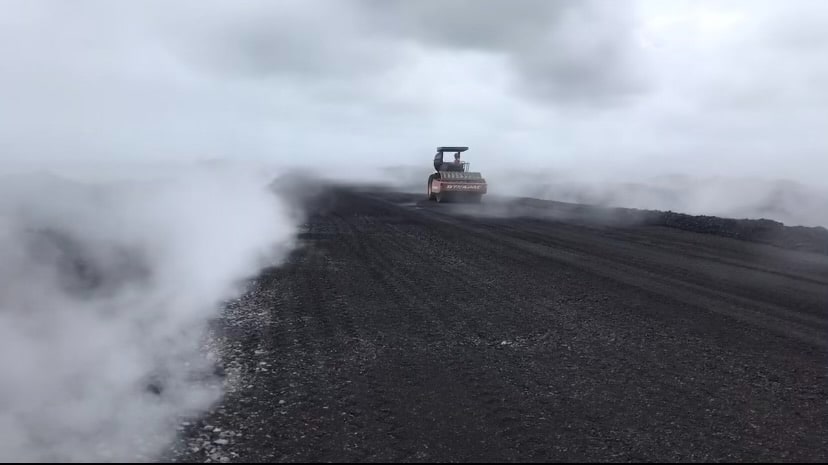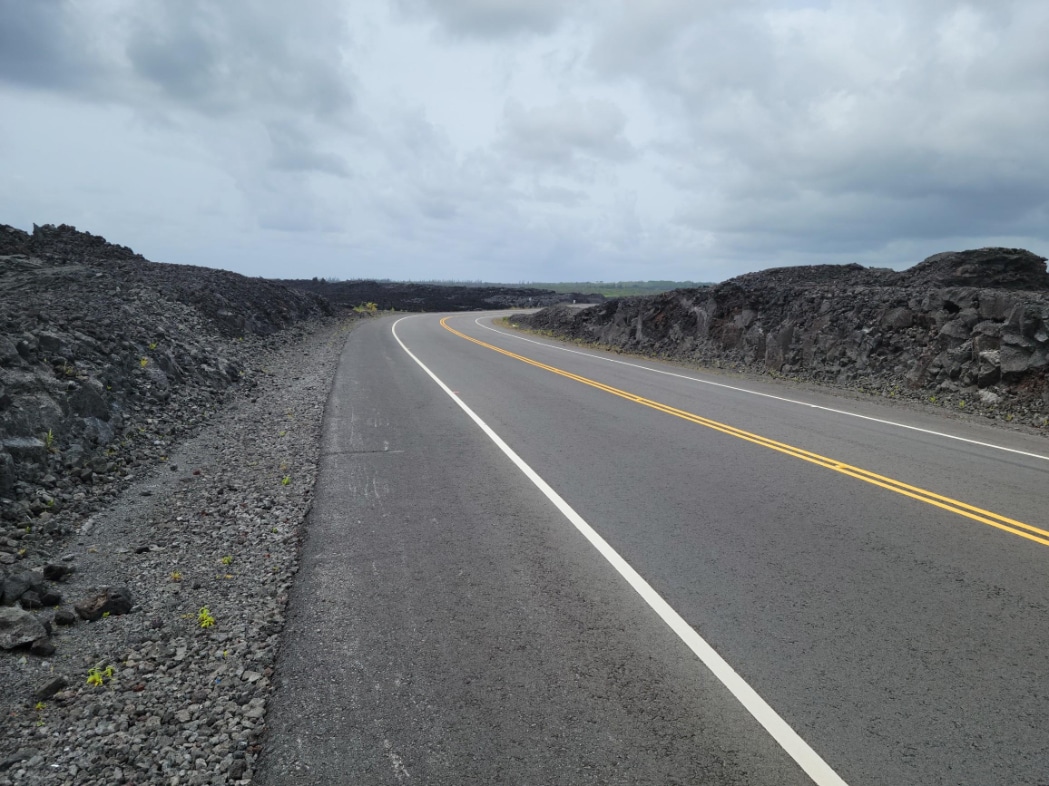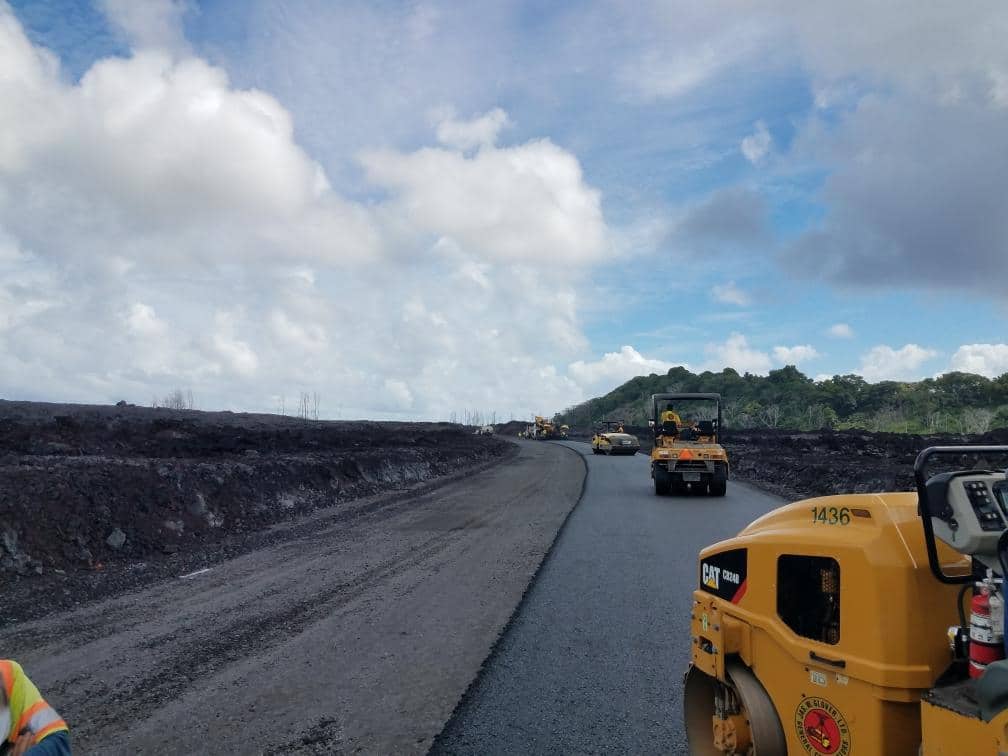Paving Over Lava: Remembering Highway 132 Project Challenges Five Years After Kilauea Eruption
BY Jayanth Kumar Rayapeddi Kumar, P.E.

The gently meandering Kopoho Road—or Highway 132—on the eastern flank of the Big Island of Hawaii connects the picturesque town of Pahoa and the easternmost point of the Big Island, Cape Kumakahi. The two-lane road cuts through beautiful patches of agricultural farmland tucked in between long stretches of hardened lava hemmed with angular blocks of annealed volcanic rock from the 2018 Kilauea volcanic eruption.
The fiery fountains of hot bright orange molten rock measuring thousands of degrees flowed downhill, crossed portions of Highway 132, and annihilated everything in their path. Homes and farmlands that were once thriving now encapsulated from the lava flow have tragically become memories and tales for the affected Kamaaina (Hawaii resident). For the few lucky ones whose homes were unconsumed, the buildings seem to have sunk several feet below the ground with a prodigious sea of black volcanic rock surrounding them. The flow created berms of black molten rock across the road. In some cases, these were as tall as 60 feet.
Saddle Road Improvements Safely Connect Hawaiian Communities
The schedule suffered some early setbacks as contractors encountered pockets of very hot lava rock measuring over 800°F, which damaged their construction equipment.
The Hawai’i County Department of Public Works (DPW), with the support of the Federal Highway Administration (FHWA), wasted no time to put in place a plan to clear the debris and reopen the road to reestablish road connectivity and residential access. Two separate sections of the highway between the Puna Geothermal Venture and the area once called “Four Corners” had to be cleared for roadway reconstruction. The sections were about 8,200 feet and 8,900 feet long with a difference in elevation of about 600 feet between them.

Highway 132 was re-opened to the public in November 2019. While the county hasn’t closely monitored pavement condition, this photo from April 2022 shows the clean mat flanked by banks of hardened lava.
Excavation of lava covering the road started in June 2019 with a target completion deadline of October 2019. However, the schedule suffered some early setbacks as contractors encountered pockets of very hot lava rock measuring over 800°F, which damaged their construction equipment. Because of this, the FHWA approved the extension request from the DPW and reset the road restoration completion deadline to Jan. 5, 2020.
Contractors were quick and effective in bulldozing massive amounts of “cooled” hardened rock that had covered the road. Even then, the vertical alignment of the road was redesigned because bulldozing the lava rock down to the original roadbed was perhaps seen as more work than it was to pave the road at a higher elevation. The change in vertical alignment was about 50 feet at the highest point. The highway’s horizontal alignment was not altered.
On the prepared base course, random areas of about 30 to 50 feet long across the width of the road billowed water vapor from the underlying steam vents. The temperature of the base course over the steam vents was over 300°F. Other areas of the base course were at ambient temperature. The air temperature was quite warm because of the heat emanating from the base course and the bulldozed lava rock piled on either side of the road.
Bobby-van Krueger and Gregg Kimata, quality control (QC) technicians for Jas. W. Glover Ltd. (Glover), based in Hawaii, reminisced about the heat emanating from the ground and the excavated rock piled on the sides of the road saying, “The heat from the ground was so much that there was steam coming out from the base layer after water was sprayed.”
Pavement Maintenance Methods in Hawaii Preserve Roads for Perpetuity
Glover, an asphalt mix producer and laydown contractor, started asphalt paving work in September 2019. The scope of the project included paving one layer of 4-inch thick hot-mix asphalt base course (HMABC) on the prepared base course at 34-foot total width. The company’s asphalt plant located in Waimea supplied the HMABC mix that was used for the project.
A total of about 13,000 tons of asphalt mix was used to pave both sections of the highway. Glover’s QC department designed the mix and maintained strict production quality control of the material that was delivered to the project. There was constant communication among lab technicians, field technicians, paving foreman, and the plant operator about the quality of the material being produced and placed. This helped to consistently deliver a high-quality product without any nonconformities throughout the project.
Glover’s QC technician Giles Nakamoto mentioned, “HMABC is a material we have a lot of experience in producing, monitoring and working with. We monitored the lab test results very closely, and anytime we saw a parameter running away from the target, we adjusted the material at the plant to make sure the parameter stayed closer to the target value.”

Rollers compacted the freshly laid asphalt mix.
Creative Rolling
The asphalt paving operation on Highway 132 was distinctively different from other projects. While the asphalt laydown process was normal, rolling operation was unique and time consuming. While mat temperatures that are slightly higher than ambient air and base course temperatures are helpful in providing a larger window to achieve mat density, paving over parts of a hot base course that was emitting heat upwards proved to be the source of the problem.
“We could feel the heatwaves. It was quite an experience to work on that project,” said Mike Araki, another Glover QC technician.
Although the air temperature made it uncomfortable, the asphalt mix laydown experience was nothing out of the ordinary. For rolling operation, the most-common approach of densifying the mat using a rolling train with breakdown, intermediate, and a finish roller operating consecutively behind the paver was used. In areas where the steam vents were underneath the base course layer, the heat from the steam vents kept the freshly laid hot asphalt mat hotter than the desired temperature range for intermediate and finish rolling for a prolonged period. As a result, the HMA over these areas constantly moved under the weight of the rollers and delayed the rolling operation. The crew had to slow the paving process down to allow the finish roller to catch up.
The project could not be extended indefinitely to allow the base course to cool down to ambient temperature before placing the asphalt mix. To overcome this problem, the project engineering team and the paving crew worked out a two-pronged solution.
- One, spray water multiple times over areas of the prepared aggregate base above the steam vents to cool the surface to make it conducive for paving.
- Two, because it was observed that even three hours after the mix was placed, the surface temperature of the mat in areas above the steam vents was between 200 and 300°F, to add a second finish roller. The plan was to use the breakdown, intermediate, and first finish rollers in all areas of the mat. The second finish roller would come into play after three hours or so after the mix was laid down to iron out all the lines left by the other rollers only in areas that had steam vents underneath.
As it turned out, spraying water was not helpful, as all the water just evaporated without cooling the base course. However, adding the second finish roller to the roller train was the key in achieving a clean and smooth finished mat.
Good communication and coordination between the paving foreman and plant operator was critical to the consistent supply of material to the paver. The roller operators and QC technicians worked together to set up the rolling pattern, which was used as the reference for making subsequent adjustments. The field density monitoring was done using a nuclear density gauge. Randomly drilled cores extracted from the finished pavement that were used for acceptance based on core thickness and density met the project requirements satisfactorily.
After the paving and rolling operation was completed, the roads were striped, signs were installed, and the roadway was inspected to make sure all the contract requirements were met. The road was reopened well ahead of FHWA’s revised deadline of Jan. 5, 2020. On Nov. 26, 2019, Mayor Harry Kim of Hawaii County tweeted “Highway 132 reopens Wednesday, November 27 at noon. Mahalo, Hawaii County Public Works, and Happy Thanksgiving!”
Challenges are not uncommon in paving projects. But the obstacles the paving crew faced with paving two sections of Highway 132 that were affected by the 2018 Kilauea volcanic eruption were unique. As the adage goes, unique problems need unique solutions. Glover took on the challenge that very few contractors have experience with and developed custom solutions to overcome the hurdles.
Overall, the consistency in mix production, laboratory testing, laydown and rolling operations, and the field density monitoring, combined with the coordination and communication among all the different teams made this unique and historic paving opportunity a successful project.
An original version of this article appeared in the Hawaii Asphalt Paving Industry newsletter and this is used with permission.
